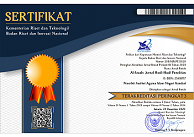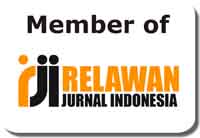Perjumpaan Pasar dan Dakwah: Ekspresi Kesalehan Anak Muda dan Komodifikasi Agama di Muslim United Yogyakarta
Abstract
Keywords
Full Text:
PDFReferences
Anggrisia, Nur Fitria. “Agama Sebagai ‘Komoditas’? Memosisikan Majelis Shalawat Sebagai Waralaba Religius.” TRILOGI: Jurnal Ilmu Teknologi, Kesehatan, Dan Humaniora 1, no. 1 (August 6, 2020): 42–51. https://doi.org/10.33650/trilogi.v1i1.1595.
Berger, Arthur Asa. Media and Communication Research: An Introduction to Qualitative and Quantitative Aproach. London: Sage Publication Ltd, 2000.
Campbell, Heidi A. Digital Religion (Understanding Religious Practice in New Media Worlds. London and New york: Routledge Taylor and Francis Group, 2013.
Casanova, Cose. “Public Religions In The Modern World.” London: The University of Chicago Press, 1994.
Creswell, J, and W. Qualitatif Inquiry and Research Design”. California: Sage Publication, Inc, 1998.
Creswell, Jamie, and Bryan Wilson, eds. New Religious Movement: Challenge and Response. London & New York: Routledge, 1999.
Dale F Eickelman, Salvatore. Public Islam and The Common Good. Leiden and Basto: Brill, 2004.
Desryani, Veby Nur. “Hubungan Antara Harga Diri Dan Gaya Hidup Hedonisme Dengan Body Image.” Motivasi 3, no. 1 (2015): 103-11-.
Einstein, Mara. Brands of Faith: Marketing Religion in a Commercial Age. New York: Routledge, 2008.
Fajriani, Suci Wahyu. “Hijrah Islami Milenial Berdasarkan Paradigma Berorientasi Identitas.” Sosioglobal : Jurnal Pemikiran Dan Penelitian Sosiologi 3, no. 2 (July 13, 2019): 76. https://doi.org/10.24198/jsg.v3i2.21643.
Haenni, Patrick. The Economic Politics of Muslim Consumption. Cambridge: Cambridge Scholars Publishing, 2019.
Haryadi, Didid, and Aris Munandar. “Tafsir Kesalehan Sosial Bagi Anggota Komunitas Hijrah Terang Jakarta Dan Shift Bandung.” Jurnal Sosiologi Reflektif 15, no. 2 (April 24, 2021): 272. https://doi.org/10.14421/jsr.v15i2.1992.
Hefner, Robert W. “Expressing Islam: Religious Life and Politics in Indonesia.” Edited by Indonesia By Greg Fealy and Sally White. Journal of Islamic Studies 21, no. 3 (September 1, 2010): 479–82. https://doi.org/10.1093/jis/etq058.
Hoesterey, James Bourk. “Marketing Islam: Entrepreneurial Ethics and the Spirit of Capitalism in Indonesia.” Practical Matters Journal 10, no. Spring (2017): 1–14.
Howell, Julia Day. “‘Calling’ and ‘Training’: Role Innovation and Religious De-Differentiation in Commercialised Indonesian Islam.” Journal of Contemporary Religion 28, no. 3 (October 2013): 401–19. https://doi.org/10.1080/13537903.2013.831650.
Kimball, Charles. When Religion Becomes Evil. New York: Harverollins Publisher, 2008.
Mughni, Syafiq A. Di Balik Simbol: Memahami Pesan Agama Dengan Semangat Kemajuan. Surabaya: Hikmah Press, 2011.
Rudnyckyj, Daromir. “Market Islam in Indonesia.” Journal of the Royal Anthropological Institute 15 (May 2009): S183–201. https://doi.org/10.1111/j.1467-9655.2009.01549.x.
Saputra, Eko, Muhammad Irham, and Firmanda Taufiq. “Komodifikasi Produk Keagamaan: Studi Di Komunitas Teras Dakwah.” Journal Managmen Dakwah 7, no. 1 (2021): 167–95. https://doi.org/https://doi.org/10.14421/jmd.2021.71-07.
Suffah, Fathiyah Dzurriyati. “Makna Hijrah Dalam Pembentukan Konsep Diri: Studi Fenomenologi Pada Shift Gerakan Pemuda Hijrah Di Masjid Al-Lathiif Bandung.” Thesis UIN Sunan Gunung Djati Bandung, 2019.
Triantoro, Dony Arung, Eko Saputra, and Tri Wahyuni. “Mengelola Hibridasi Identitas Anak Muda Islam: Studi Pada Lembaga Teras Dakwah Di Yogyakarta.” Jurnal MD 5, no. 2 (December 1, 2019): 113–39. https://doi.org/10.14421/jmd.2019.52-01.
Zahara, Mila Nabila, and dkk. “Hijrah Movement: Millenial Muslim Identity Seeking In The Digital Era.” Indonesian Journal Of Sociology, Education and Development 2, no. 1 (2020): 53–54.
DOI: http://dx.doi.org/10.31332/ai.v0i0.3843
Copyright (c) 2022 Hofizal Wadi, Roy Bagaskara

This work is licensed under a Creative Commons Attribution-NonCommercial-ShareAlike 4.0 International License.










